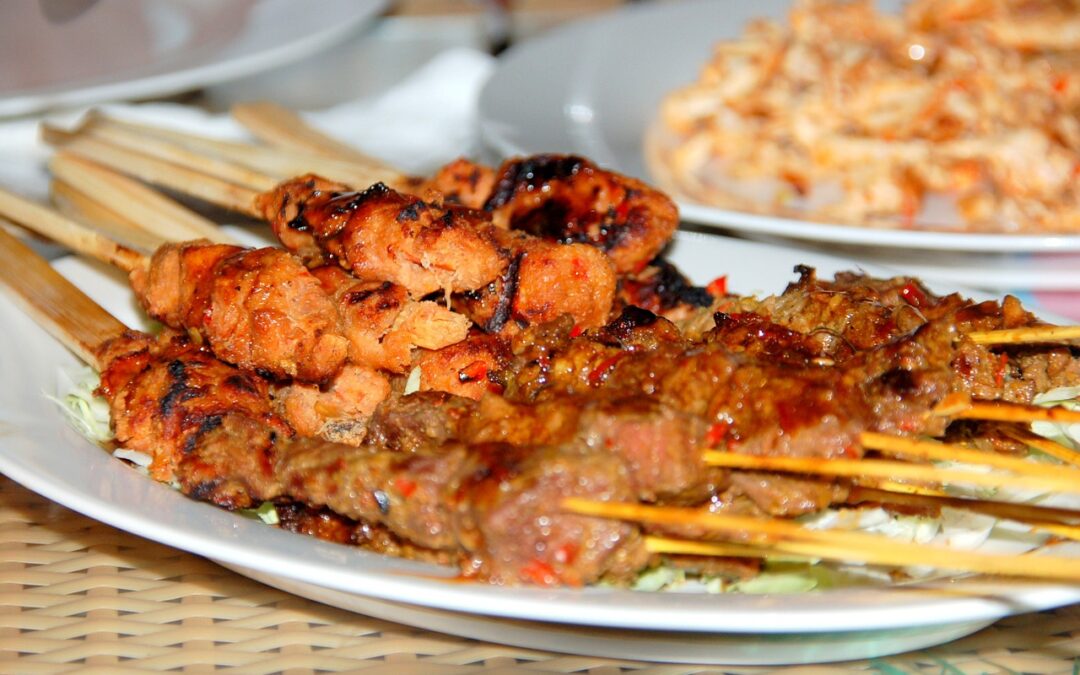Bali, the Island of the Gods, not only captivates visitors with its stunning landscapes and vibrant culture but also tantalizes their taste buds with its rich culinary heritage. Balinese cuisine offers a delightful fusion of flavors, combining traditional Indonesian spices with unique local ingredients. In this article, we will explore ten must-try traditional Balinese foods, providing insights into their preparation, cultural significance, and whether they are Halal or Non-Halal for Muslim travelers. So, let’s embark on a gastronomic journey through Menjangan and Tulamben, two beautiful places where you can savor these authentic culinary delights.
1. Babi Guling (Roast Suckling Pig):
Babi Guling is a celebrated Balinese dish and is often considered the crown jewel of Balinese cuisine. It is a whole suckling pig that is meticulously seasoned with a blend of spices like turmeric, coriander, ginger, and garlic. The pig is then slowly roasted over an open fire until the skin becomes crispy and golden, while the meat remains tender and succulent. It is important to note that Babi Guling is a Non-Halal dish due to the use of pork.
2. Betutu:
Betutu is another iconic Balinese dish that showcases the island’s love for slow-cooked flavors. Typically made with chicken or duck, the meat is marinated in a rich spice paste called “Base Gede,” which includes ingredients like shallots, garlic, ginger, turmeric, chili, and shrimp paste. After marinating, the meat is wrapped in banana leaves and slow-cooked for several hours until it becomes tender and infused with the aromatic spices. Betutu can be prepared using either Halal or Non-Halal ingredients, depending on the choice of meat.
3. Nasi Campur:
Nasi Campur, meaning “mixed rice,” is a popular Balinese dish that allows you to experience a variety of flavors in one meal. It typically consists of fragrant steamed rice served with an array of side dishes such as grilled chicken, sate (skewered meat), crispy fried tempeh, seasoned vegetables, and spicy sambal (chili paste). The combination of different textures and flavors creates a satisfying and well-rounded culinary experience. Both Halal and Non-Halal versions of Nasi Campur are available, depending on the choice of meat.
4. Nasi Jinggo:
Nasi Jinggo is a beloved Balinese street food that comes packaged in small portions wrapped in banana leaves. It is commonly consumed as a quick and convenient meal. The star of the dish is fragrant white or yellow rice mixed with various side dishes and sambal (chili paste). The side dishes can include sambal goreng (fried tempeh), fried noodles, vegetables, egg, and other optional accompaniments. Nasi Jinggo can be prepared using both Halal and Non-Halal ingredients, depending on the choice of side dishes.
5. Lawar:
Lawar is a traditional Balinese dish that reflects the island’s love for fresh ingredients and bold flavors. It is a vibrant salad made with finely chopped vegetables, grated coconut, and minced meat. The meat used can be either pork or chicken, depending on personal preference. A blend of herbs and spices like turmeric, ginger, galangal, and shrimp paste adds depth and complexity to the dish. Lawar can be prepared using either Halal or Non-Halal ingredients, depending on the choice of meat.
6. Sate Lilit:
Sate Lilit is a unique variation of the popular Indonesian satay. Instead of skewering chunks of meat, Sate Lilit features minced meat blended with grated coconut and a medley of aromatic spices. The mixture is then delicately wrapped around lemongrass sticks or bamboo skewers before being grilled to perfection. Sate Lilit offers a burst of flavors and a tender texture that sets it apart from other satay variations. It can be enjoyed by both Halal and Non-Halal food enthusiasts, depending on the choice of meat.
7. Tum Ayam:
Tum Ayam is a popular Balinese dish prepared by tightly wrapping minced chicken in banana leaves and steaming it to perfection. The chicken is seasoned with a blend of aromatic herbs and spices, including shallots, garlic, ginger, lemongrass, and chili. The banana leaves impart a subtle earthy flavor to the dish, while the steaming process ensures the chicken remains tender and moist. Tum Ayam is a Halal dish and is suitable for Muslim travelers seeking delicious and authentic Balinese flavors.
8. Sambal Matah:
Sambal Matah is a traditional Balinese condiment that adds a burst of flavor to any meal. It is made from a combination of finely chopped shallots, lemongrass, chili peppers, kaffir lime leaves, and coconut oil. The ingredients are mixed together, creating a zesty and fragrant condiment that pairs well with grilled meats, seafood, or rice dishes. Sambal Matah is typically Halal, but it’s always advisable to check if additional non-Halal ingredients are used in specific preparations.
9. Jaje Bali:
Jaje Bali refers to a variety of traditional Balinese sweets and desserts. These colorful delicacies are often made for special occasions or religious ceremonies. Jaje Bali encompasses a wide range of treats, including sticky rice cakes, coconut-based sweets, and fried pastries filled with palm sugar or grated coconut. The unique combination of flavors, textures, and vibrant colors makes Jaje Bali a delightful treat for both the eyes and taste buds. Most Jaje Bali sweets are Halal, but it’s important to inquire about specific ingredients and preparation methods.
10. Rujak Kuah Pindang:
Rujak Kuah Pindang is a traditional Balinese dish that offers a delightful blend of flavors by combining fruits with a savory fish gravy. This unique twist on the concept of rujak, a fruit salad typically served with a sweet and spicy dressing, sets Rujak Kuah Pindang apart from other Balinese dishes. For Muslim travelers seeking Halal options, Rujak Kuah Pindang can be considered Halal. Although the dish traditionally incorporates fish gravy, it does not contain any non-Halal ingredients and can be prepared using Halal-certified fish. It is always advisable to inquire about the specific ingredients and preparation methods when ordering Rujak Kuah Pindang to ensure its Halal status.
In addition to the main dishes, Balinese cuisine also offers a wide range of snacks and desserts that are perfect for satisfying your sweet tooth. Some popular options include Pisang Goreng (fried bananas), Klepon (rice cakes filled with palm sugar), and Es Campur (mixed shaved ice dessert). These snacks can be found at local markets and street vendors, providing a quick and tasty snack while exploring the island.
Where to Find Traditional Balinese Food:
When visiting Menjangan and Tulamben, try some of these delectable local dishes such as Betutu and Sate Lilit at our Sunset Beach Restaurant and Tunjung Restaurant. We also highly recommend going on an excursion to traditional markets nearby such as Pasar Goris in Menjangan and Pasar Culik in Tulamben to savour the wide selection of authentic Balinese ingredients, ready-to-eat dishes and traditional sweets.
For Muslim travelers seeking Halal options, it’s crucial to communicate your dietary preferences and requirements to ensure a suitable dining experience. While these traditional Balinese dishes are generally Halal-friendly, it’s recommended to confirm with the restaurant or eatery about the specific ingredients and preparation methods used.
Conclusion:
Exploring the culinary delights of Bali is an essential part of any visit to the island. From the succulent Babi Guling to the flavorful Sambal Matah, the delightful Jaje Bali to the refreshing Rujak Kuah Pindang, these traditional Balinese dishes offer an unforgettable gastronomic experience. With their unique flavors, expertly crafted recipes, and cultural significance, these dishes provide a glimpse into the rich culinary heritage of Bali. So, as you venture through Menjangan and Tulamben, don’t miss the opportunity to indulge in these must-try Balinese delicacies and create lasting memories of your visit to this enchanting island.


